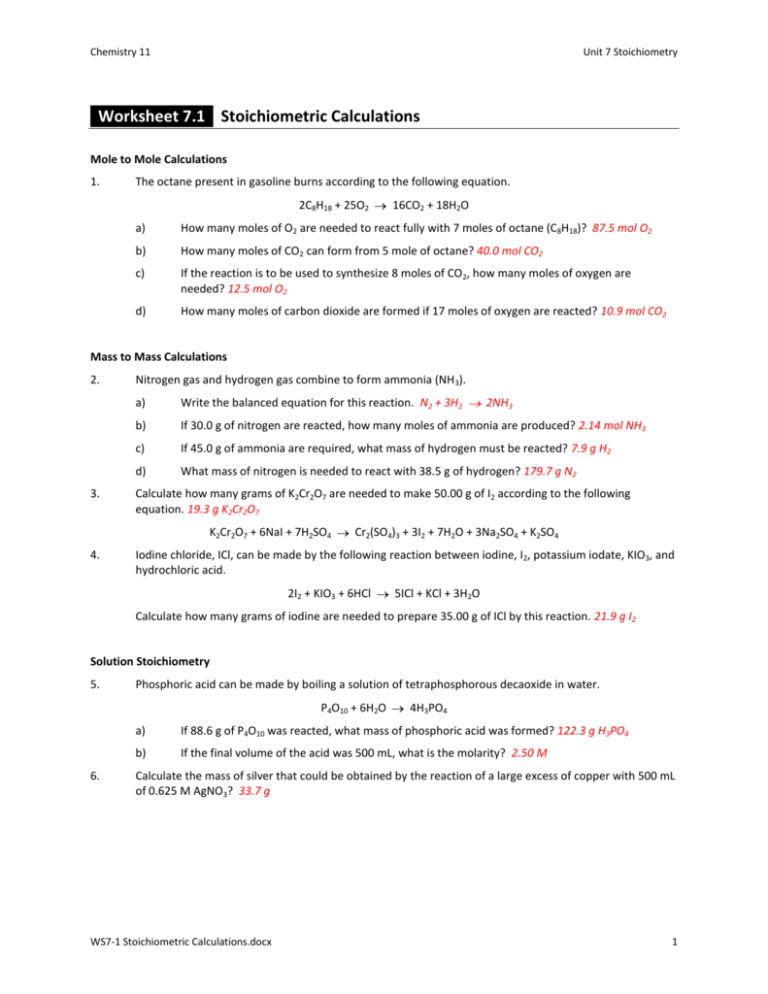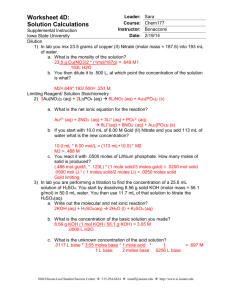Worksheet 7.1 Stoichiometric Calculations
advertisement

Chemistry 11 Unit 7 Stoichiometry Worksheet 7.1 Stoichiometric Calculations Mole to Mole Calculations 1. The octane present in gasoline burns according to the following equation. 2C8H18 + 25O2 16CO2 + 18H2O a) How many moles of O2 are needed to react fully with 7 moles of octane (C8H18)? 87.5 mol O2 b) How many moles of CO2 can form from 5 mole of octane? 40.0 mol CO2 c) If the reaction is to be used to synthesize 8 moles of CO2, how many moles of oxygen are needed? 12.5 mol O2 d) How many moles of carbon dioxide are formed if 17 moles of oxygen are reacted? 10.9 mol CO2 Mass to Mass Calculations 2. 3. Nitrogen gas and hydrogen gas combine to form ammonia (NH 3). a) Write the balanced equation for this reaction. N2 + 3H2 b) If 30.0 g of nitrogen are reacted, how many moles of ammonia are produced? 2.14 mol NH3 c) If 45.0 g of ammonia are required, what mass of hydrogen must be reacted? 7.9 g H2 d) What mass of nitrogen is needed to react with 38.5 g of hydrogen? 179.7 g N2 Calculate how many grams of K2Cr2O7 are needed to make 50.00 g of I2 according to the following equation. 19.3 g K2Cr2O7 K2Cr2O7 + 6NaI + 7H2SO4 4. 2NH3 Cr2(SO4)3 + 3I2 + 7H2O + 3Na2SO4 + K2SO4 Iodine chloride, ICl, can be made by the following reaction between iodine, I2, potassium iodate, KIO3, and hydrochloric acid. 2I2 + KIO3 + 6HCl 5ICl + KCl + 3H2O Calculate how many grams of iodine are needed to prepare 35.00 g of ICl by this reaction. 21.9 g I2 Solution Stoichiometry 5. Phosphoric acid can be made by boiling a solution of tetraphosphorous decaoxide in water. P4O10 + 6H2O 6. 4H3PO4 a) If 88.6 g of P4O10 was reacted, what mass of phosphoric acid was formed? 122.3 g H3PO4 b) If the final volume of the acid was 500 mL, what is the molarity? 2.50 M Calculate the mass of silver that could be obtained by the reaction of a large excess of copper with 500 mL of 0.625 M AgNO3? 33.7 g WS7-1 Stoichiometric Calculations.docx 1 Chemistry 11 7. Unit 7 Stoichiometry Phosphoric acid can be neutralized by sodium hydroxide according to the following reaction. ___ H3PO4(aq) + ___ NaOH(s) 8. ___ Na3PO4(aq) + ___ H2O(l) a) Balance this equation. 1, 3, 1, 3 b) If 3.75 moles of NaOH are reacted, how moles of H3PO4 can be neutralized? 1.25 mol c) What mass of NaOH would be required to completely neutralize 325 mL of 0.750 M H3PO4? 29.3 g d) What volume of 2.75 M NaOH solution would be required to neutralize 500 mL of 0.750 M H3PO4? 409.1 mL Consider the following neutralization reaction: ___ H3PO4 + ___ KOH ___ K3PO4 + ___ H2O a) Balance the equation. 1, 3, 1, 3 b) What is the [H3PO4] when a 25.0 mL sample of H3PO4 is titrated with 76.4 mL of 0.350 M KOH. 0.357 M c) What volume of 0.150 M H3PO4 is required to titrate 30.0 mL of 0.250 M KOH? 16.7 mL d) What is the [KOH] when 25.0 mL of KOH is titrated with 13.9 mL of 0.125 M H 3PO4? 0.209 M Gas Stoichiometry 9. Consider the following reaction: ___ N2(g) + ___ H2(g) 10. ___ NH3(g) a) Balance the equation. 1, 3, 2 b) If 25.0 g of nitrogen react with oxygen, what volume of NH3 is produced at STP? 40.0 L c) What mass of hydrogen is required to produce 50.0 L of NH3 at STP? 6.70 g Tin (II) fluoride is formed in the reaction, Sn(s) + 2HF(g) SnF2(s) + H2(g) a) 24 How many grams of SnF2 can be made by reacting 7.42 × 10 molecules of HF with tin? 965.7 g b) How many litres of hydrogen gas (at STP) are produced by reacting 23.4 g of Sn with HF? 4.42 L c) How many litres of HF are needed to produce 14.2 L of H 2 (at STP)? 28.4 L d) How many molecules of H2 are produced by the reaction of tin with 80.0 L of HF (at STP)? 24 1.08 × 10 H2 WS7-1 Stoichiometric Calculations.docx 2








